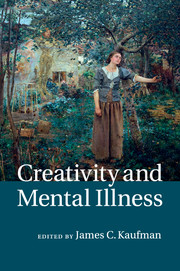Book contents
- Frontmatter
- Dedication
- Contents
- List of figures
- List of tables
- List of contributors
- Preface
- Acknowledgments
- Part I Creativity and mental illness: the state of the field
- Part II Cognitive and neuroscientific perspectives on creativity and mental illness
- 5 Neurocognitive mechanisms underlying creative thinking: indications from studies of mental illness
- 6 The evolutionary genetics of the creativity–psychosis connection
- 7 Non-linearity in creativity and mental illness: the mixed blessings of chaos, catastrophe, and noise in brain and behavior
- 8 Artists’ vulnerability to psychopathology: an integrative cognitive perspective
- Part III Creativity and the spectrum of mental illness
- Part IV Creativity and mental illness: possible commonalities
- Part V Creativity and mental health
- Part VI Creativity and mental illness: what now?
- Index
- References
5 - Neurocognitive mechanisms underlying creative thinking: indications from studies of mental illness
from Part II - Cognitive and neuroscientific perspectives on creativity and mental illness
Published online by Cambridge University Press: 05 August 2014
- Frontmatter
- Dedication
- Contents
- List of figures
- List of tables
- List of contributors
- Preface
- Acknowledgments
- Part I Creativity and mental illness: the state of the field
- Part II Cognitive and neuroscientific perspectives on creativity and mental illness
- 5 Neurocognitive mechanisms underlying creative thinking: indications from studies of mental illness
- 6 The evolutionary genetics of the creativity–psychosis connection
- 7 Non-linearity in creativity and mental illness: the mixed blessings of chaos, catastrophe, and noise in brain and behavior
- 8 Artists’ vulnerability to psychopathology: an integrative cognitive perspective
- Part III Creativity and the spectrum of mental illness
- Part IV Creativity and mental illness: possible commonalities
- Part V Creativity and mental health
- Part VI Creativity and mental illness: what now?
- Index
- References
Summary
Creative people who can’t but help explore other mental territories are at greater risk, just as someone who climbs a mountain is more at risk than someone who just walks along a village lane.
– R. D. LaingOne must still have chaos in oneself to be able to give birth to a dancing star.
– Friedrich NietzscheThe magnetic appeal of the nexus between madness and creativity has persevered over centuries. The ubiquity of this fascinating idea is no doubt primarily due to the greater incidence of mental illness associated with professions that purportedly involve a high degree of creativity (e.g., Post, 1994). However, its remarkable persistence can be attributed, at least in part, to the shared characteristics of mental illness and creativity. Both are associated with a high tolerance for ambiguity, the ability to go beyond generic conceptual connections, and the adoption of alternative perspectives. Despite the considerable interest in this theme and concerted efforts to demystify the ineffability surrounding it, the precise manner in which enhanced creative abilities can be related to mental illness has remained a difficult one to pin down.
There are several reasons for this. One is that creativity itself is an extremely multifaceted and heterogeneous construct for which few comprehensive or unifying information-processing frameworks have been proposed (Dietrich, 2004). In addition, while several measures have been developed to assess creative thinking, most do not specify which particular facets of creativity are assessed within the tasks because related psychometric work is lacking (Arden et al., 2010). For example, clarifications about the manner in which any creativity measure is comparable to or differentiable from other creativity tasks are usually absent. Moreover, unlike in the case of personality tests, for instance, the lack of comprehensive reliability or validity indices accompanying creativity tests makes it difficult to estimate the efficacy of, not just the measures in question, but also their associated concepts. So making clear claims about creative thinking in relation to almost any variable is extremely challenging.
- Type
- Chapter
- Information
- Creativity and Mental Illness , pp. 79 - 101Publisher: Cambridge University PressPrint publication year: 2014
References
- 5
- Cited by



